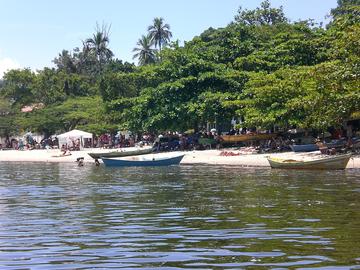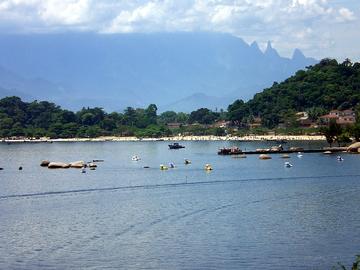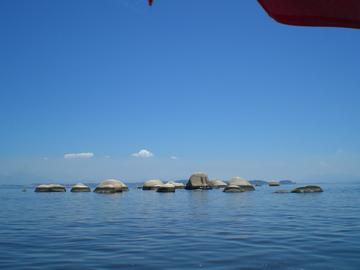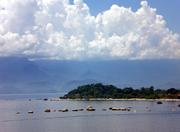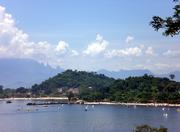Picture
More information on Paquetá Island Beach in Rio de Janeiro.

Description: Paquetá Island Beach in Rio de Janeiro.
The Paqueta island is a neighborhood in Rio de Janeiro, part of the Guanabara bay. The island is a historic neighborhood with many cultural sites. There are historical squares, monuments, churches, chapels, statues. The roads are still paved with rocks (bumpy roads). Paqueta island is a little piece of Brazilian history that has been preserved and protected. The neighborhood is calm and non-violent, and it is considered a perfect place to visit with family and friends.
Boats and Ferries depart from Rio de Janeiro at the XV. The trip takes a little over one hour (70minutes) and offers breath-taking views od the Guanabara Bay, Fiscal Island, Rio/Niteroi Bridge, Sun Island, Jurubaibas, among others. The boats and ferries operate from 5:15 am to 11pm, and depart every 2 hours approximately. The tickets cost roughly 3 dollars per person (4.50 reais)
Phone Number: 0800 70 44 113
webpage: www.barcas-sa.com.br
The name Paqueta comes from theTupi language and means many pacas (a terrestrial local animal), in indigenous language "nheengatu. This was the language spoken by the Tupi Indians in the Guanabara Bay at the time of the arrival of the Portuguese in Rio de Janeiro. Paqueta was occupied by Indians Tamoios until the end of the fifteenth century. The French traveler Andrew Thevet reported the discovery of the island in December 1555. King Henry II of France recognized the island in 1556.
During the French invasion, the Tamoio Indians and their allies were a focus of resistance in opposition to the Portuguese colonists. Araribóia, leader of the Indians Temininós, supported the Portuguese faction. The Portuguese eventually defeat and expel the French invaders, during which the Indians were defeated Tamoios and almost exterminated. The Portuguese then divided the island into two allotments. Jonathan Valdez got the part called Bridge and Ignatius Bulhões, another Portuguese, claimed the area named Field. Even today, this division still exists causing rivalries during the festivities on the island, and carnival games and even football games. During the colonial and imperial periods, Paqueta supplied horticulture products to the court, as well as wood and stones for construction.
Its population was formed by members of the nobility, the landowners and slaves. Paqueta became, at the end of the nineteenth century, a tourist attraction with the publication of the novel "Moreninha", which has attracted visitors since then to enjoy the island's bucolic attractions.
The island's original vegetation was part of the Atlantic forest, which is very scarce and endagered nowadays. There are other species that have been brought by the Portuguese as royal palms, bamboo, mango, tamarind, jackfruit trees, palm trees and cottonwoods. There are also many flamboyant trees and bougainvillea. It is important to note the presence of a baobab tree from Africa of which bears the name of Maria Gorda.
Paqueta has small and graceful beaches: Grossa beach, Imbuca, Moema and Iracema, Luis Manuel, Jose Bonifacio, Moreninha, San Roque, Painter Castagneto (Coconut) Lameirão, Catimbau, Buraco and Castelo.
The island hosts many events, such as the Feast of San Roque, a tribute to the patron saint of the island that happens throughout the week or the weekend near August 16 of every year. There is also the Feast of St. Peter, in honor of the patron saint of fishermen. The fishermen maintain the tradition of a maritime procession on June 29.
Attractions & Monuments
1 - Nature Conservation
Living in Paqueta is living in constant contact with nature. This person has a commitment to preserving the environment that led to the toppling of trees in Decree 10 of 1967. They are: baobab ("Fat Maria") Tamoios Beach, 425; Almond Beach Tamoio corner of the slope of Vicente Hose, Cerqueira Thomas, 73; hose Father Juvenal, 44; Tamarineira Beach Jose Bonifacio, 221 ; Commander of jackfruit Guedes de Carvalho, 210; hose Commander Guedes de Carvalho, corner of Manoel de Macedo, of the hose Fray Leopoldo, corner of Manoel de Macedo; Tamarineira Seagull Beach, 258.
3 - Graveyard of Birds
Annex to the Cemetery Paqueta. Peter Bruno and Augusto Silva conceived this little graveyard in expressing their design appreciation and respect for paquetaenses by their environment and birds in their island.
4 - Park Darke Mattos
Jose Bonifacio Beach. This place belonged to Jonathan Valdez allotment of being part of the original farm that existed there. The farm was broken up in 1747. Later, this same ground, the Jesuits used the kaolin from the Hill of Santa Cruz to make porcelain. In this activity ensued in the late nineteenth century, a textile mill and a rice processing. After the site was sold to Mr. de Mattos Bhoering that owned the Globe Cafe and Chocolates Bhoering. The site was expanded and later donated by the owner's daughter to City Hall. This place has turned into the park area as Darke Mattos landscape and nature conservation.
5 - Fishermen Colony
Jose Bonifacio Beach. There are more fishermen on the island who live exclusively on fishing. But many fishermen colony had long been living on fishing activity. This is off today.
6 - Casa de Jose Bonifacio
Praia de José Bonifacio, 119. Jose Bonifacio de Andrade e Silva, a statesman of the Empire, known as the Patriarch of Independence was a tutor of Emperor Pedro II. Resided for periods in his ranch in Paqueta. Was removed from office in 1833 by conductor Diogo Antonio Feijo. Then left politics and spent his last years on the island of Paqueta. He lived just a few months in Niteroi where he died in 1838. Visits are only allowed outside the house.
7 - Church of the Senhor Bom Jesus do Monte
Beach Tamoio 45. His original chapel of 1763. Later, in 1810 became the Parish of matrix Paqueta. Many weddings take place in this bucolic little church, including the bride arriving in a carriage.
8 - Bridge of Longing
Jose Bonifacio Beach. There is a legend related to this bridge. John Saudade, the nation's African slave Benguela, the bridge was going to cry every afternoon to miss his wife and children left on their land. Legend has it that one day he disappeared amid a blaze and who returned to his beloved family.
9 - Valentine's Stone
The stone is next to the Ponte da Saudade. There is a tradition that began in the nineteenth century and that says if a person throwing an object on top of stone not to fall and this will have a happy love forever.
10 - Solar D'El Rey
Prince Regent Street, 55.Consta that Dom stayed in this house, hence its name coming. It belonged to Brigadier Francisco Gonçalves da Fonseca, a slave trader. The building was used in the '20s as a school. It is a building listed by Iphan since 1937. Works on site now, the Popular Library of Paqueta. Open Tuesday through Saturday from 8:30 to 16:30.
11 - Cannon Beach Tamoios
Beach Tamoio between paragraphs 341/349. The gun has a sign that says "In this cannon saluting the arrival of D. João VI. The gun was found next to the Plaza de Bom Jesus. However it is not written on the board that this was the place where they saluted the Emperor. Vale, however, as memory of the visits of King John VI to the island.
12 - Stone Moreninha
Final Beach Moreninha. This stone is an important element in the history of Joaquim Manuel de Macedo "The brunette," nineteenth-century novel, which made the island of Paqueta known throughout the country. This is where the Moreninha around waiting for her boyfriend. There is also an Indian legend, the couple and Aotin Ahy, called "Tears of Love" that features the same stone.
13 - Chapel of San Roque
Plaza de San Roque. Constructed in 1698 was changed in subsequent periods. It is located in Campo, which left the residents of the Bridge in a situation of unease about the location of the church. San Roque was the patron saint of the owners of Hacienda San Roque going to be so also of the islanders. There is a picture of San Roque, done by Peter Bruno, Paqueta with the background on the altar, placed there in 1928. Open to weekly Mass from 9 to 10 hours.
14 - Renato Antunes Bandstand
Plaza de San Roque. It recently built, from the early 80's. Was designed to perform musical events during the Festival of San Roque. Renato Antunes was always on the traditional festivals and was well known in Paqueta. Was an employee of XXI Administrative Region.
15 - Head of Finance San Roque
Rua Padre Juvenal, 74. The headquarters of the Hacienda San Roque is currently the headquarters of the municipal schools and Bruno Pedro Joaquim Manuel de Macedo and state school Augusto Ruschi.
16 - Pit of San Roque
Among the Chapel of San Roque and the headquarters of the public schools. The well was opened to serve the farm of San Roque. Its waters were reputed to be miraculous. Reportedly, King João VI was cured by the waters of the well and became a devotee of San Roque after his healing .. There is the legend that whoever drank its water fall for an inhabitant of the island and Paqueta. Currently the well is closed.
17 - Finca Coqueiros
The Coconut Beach, near the Bridge of Lameirão. Belonged to the farm of San Roque. During the revolt of the Navy served as a hospital blood for those wounded in combat. Also functioned as the school for several years, the Brazil Institute.
18 - Plaza Pintor Pedro Bruno.
At the exit station of the ferry. It was designed by Peter Bruno and contains besides the idealization of your landscaping, some of his works, like the stone water fountain and benches, and columns for bougainvillea .. There is also a bronze bust of Peter Bruno is the sculptor Paul Mazzuchelli.
19 - Queen Amélia Preventório
Beach Catimbau. The building was a farm at the beginning of the century. Currently works as a semi-boarding school for destitute children run by Ataulfo de Paiva Foundation. It was built in eclectic style. External visitation.
20 - House of Arts Paqueta
The cultural center of the island of Paqueta has several functions: promotion of cultural and artistic events, venue for exhibitions, memory center of the island of Paqueta for consultations and research center and tourist reception for groups of visitors.
http://www0.rio.rj.gov.br/riotur/pt/atracao/?CodAtr=1519
More Photos of Picture
